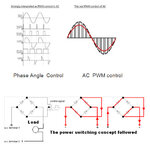Mithun_K_Das
Advanced Member level 3

- Joined
- Apr 24, 2010
- Messages
- 899
- Helped
- 24
- Reputation
- 48
- Reaction score
- 26
- Trophy points
- 1,318
- Location
- Dhaka, Bangladesh, Bangladesh
- Activity points
- 8,254
Controlling AC load using IGBT is not new idea. But as far I tested, IGBT get too hot with a little amount of AC load. Is this really possible to run heavy load such as 1~3KW using IGBT?
What I'm talking about is this:

Please share your opinion about this technology.
Note: I've tested with 100W of AC load so far. But I saw many industrial systems those are working this way so smoothly. Although all of them had enough cooling fan or even few was water cooled.
What I got, if I run a AC Lamp, it doesn't become so hot, but if I load a Fan of the same power, IGBT gets hot.
What I'm talking about is this:

Please share your opinion about this technology.
Note: I've tested with 100W of AC load so far. But I saw many industrial systems those are working this way so smoothly. Although all of them had enough cooling fan or even few was water cooled.
What I got, if I run a AC Lamp, it doesn't become so hot, but if I load a Fan of the same power, IGBT gets hot.




